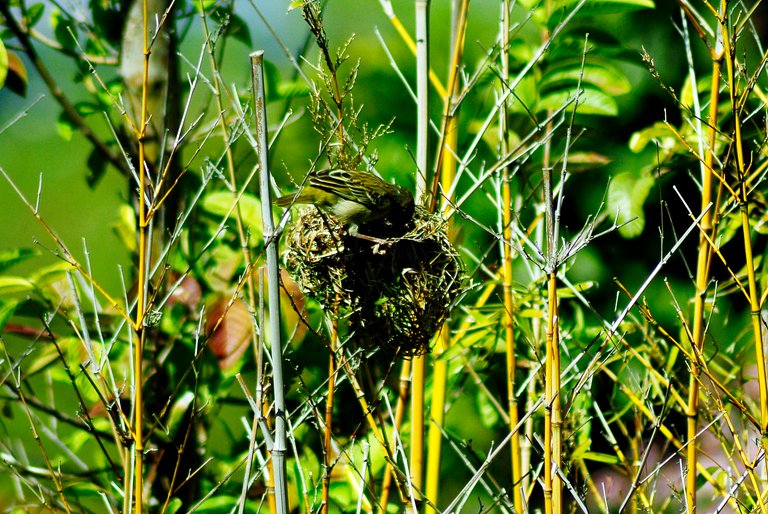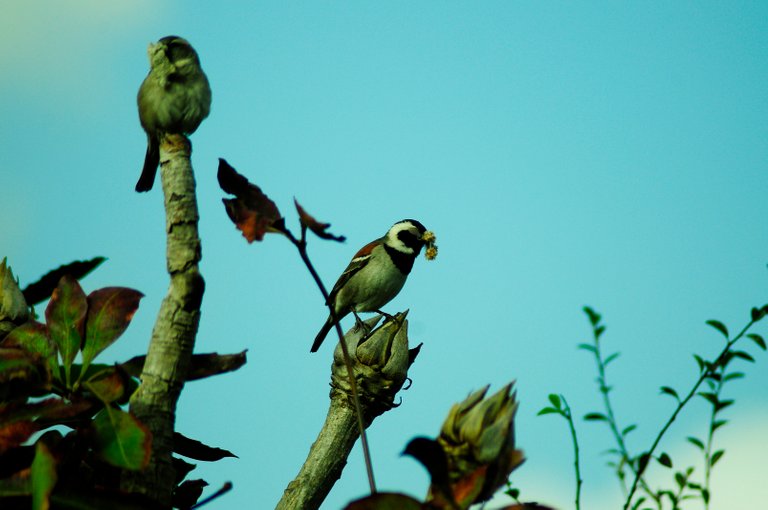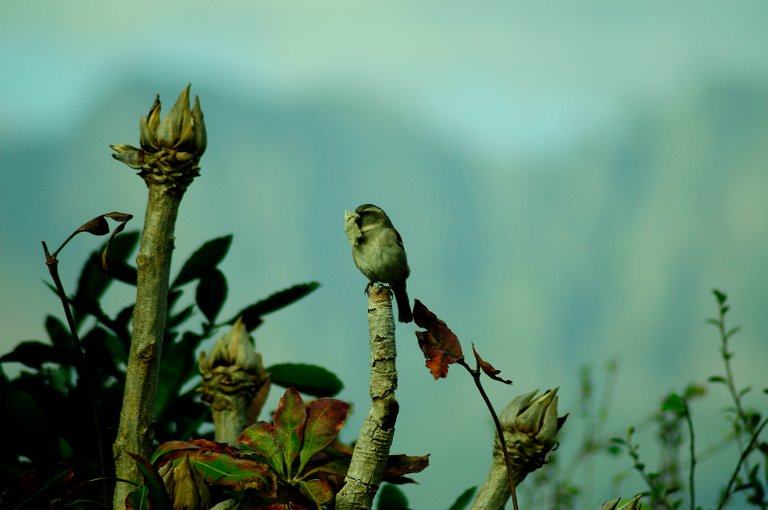
For the first time, birds are building their nests in my garden. I have found three nests being built. And what is more amazing, I have started to see them actively building them! Last week, I began following a pair of Cape sparrows (Passer melanurus) who are building their home in the patio roof. I have dubbed them man and wife. Here is wife sparrow sitting all puffed up kind of mad at me because she is too scared to fly past me.

But since finding their home, I found two more homes! Both of the newly found homes are from Cape weavers (Ploceus capensis). The first nest is in my bamboo garden, shown above in the first picture. The second nest is in one of the berry trees/shrubs.

I am still trying to figure out if these nests belong to the same birds or different ones. But as soon as I start to photograph the one, I can hear the other bird (either female or male) call the one building. That is, I am sure the one is on the lookout! Because every time I get close to either of the nests, the lookout bird begins to scream and the building bird flies away! What a system they have devised between them.

(He or she is on top of the world!)
A Funny Thing About Their Building Tactics
I am not sure if these are juvenile birds or female ones. The male is yellow and I have not spotted him yet. However, it is the male who builds the nest! So where is he? I have no idea, unless these are juvenile males. But maybe these are females. Let me tell you more about them building their nests.

I will be using these four sources and all credit goes to them. Source 1; Source 2; Source 3; Source 4.
The male will build many nests, that is why I am wondering if these two nests are built by the same male. It makes sense because the cape weaver wants to attract many females, thus he builds multiple homes! But, the immature or juvenile cape weaver also practices building homes even before he is ready to take a mate. So, maybe these are practice homes! They are not fully waterproof yet, so either they are not completely built, or they are not that good attempts by a young fellow.

So after the male has built his various homes, the females will inspect them. If one accepts the home, she will begin to furnish it with all the nice stuff she can fit! No, just kidding. She will begin to add feathers and soft things so she can lay her eggs. I think I captured a moment in which she inspected the home, or maybe she is already furnishing it:

If the female does not accept the home, the male will destroy it and build a new one. It takes about a week to build a new one. But what is interesting about these homes is that they have various functions after the weaver is done with them. For instance, the cape sparrow might move in! And I am wondering now, is the little cape sparrow not maybe stealing from the cape weaver nest when they are out and about collecting feathers?

The husband and wife are sitting very close to the cape weaver nest. The nest is basically just below them.

Tell me she does not have a naughty look in her eyes! She looks like she just grabbed that piece of furniture right out of the cape weaver nest! The same goes for her husband:

They look like naughty friends. The thing is, every now and then I hear the chirping and loud calls of the sparrows and the cape weaver. Maybe they are fighting and one is really stealing from the other. The cape weaver also has a naughty look!

Who is stealing from who? Or maybe no one is stealing! But how wonderful is it not to look at them build their homes?

This looks like a juvenile male. But I am not sure. What I am sure about is their disgust in me for looking at them. And how wonderful is their alarm system? The one calls from the other side of the garden letting them know I am approaching!

Postscriptum, or the Saga Continues!
I hope to update this nest-building saga throughout the coming weeks. It will be interesting to see how the nests grow bigger and better. I hope they survive the winds and cold days that lay ahead. If one of my conjectures is right and these are juvenile birds attempting to build their first homes, the wind might take them away as they are kind of in the open. At least one is. Hopefully, they get wives and that they lay eggs. How wonderful will it not be to see the babies and how they grow bigger! For now, I can only watch and report. I hope you learned something new from this post, I know I did from doing some research on the building of nests. Who knew that they are so picky and strange?
All of the photographs are my own, taken with my Nikon D300 and Tamron 300mm zoom lens. The musings are my own, but I hyperlinked the sources from which I gather the information relayed in this post. Until the next installment, happy birding and stay safe.

Your content has been voted as a part of Encouragement program. Keep up the good work!
Use Ecency daily to boost your growth on platform!
Support Ecency
Vote for new Proposal
Delegate HP and earn more
Cape Weaver Nest-Building is one of the unique species among the bees. Usually, the birds make their nests on the ground and the bees build their nests high in trees. You need to get Auckland Concrete cutters and learn more new thongs for managing their cutters in Auckland. The Cape Weaver is very different from other birds as its nests are made from mud and leaves. These eggs hatch after around four to five days by little larvae which start eating already when they are out of their shells.